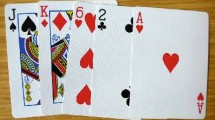Abstract
In the top to random shuffle, the first \({a}\) cards are removed from a deck of \({n}\) cards \({12 \cdots n}\) and then inserted back into the deck. This action can be studied by treating the top to random shuffle as an element \({B_a}\), which we define formally in Section 2, of the algebra \({{\mathbb{Q}[S_n]}}\). For \({a = 1}\), Garsia in “On the powers of top to random shuffling” (2002) derived an expansion formula for \({{B^k_1}}\) for \({{k \leq n}}\), though his proof for the formula was non-bijective. We prove, bijectively, an expansion formula for the arbitrary finite product \({B_{a1} B_{a2} \cdots B_{ak}}\) where \({a_{1}, \cdots , a_{k}}\) are positive integers, from which an improved version of Garsia’s aforementioned formula follows. We show some applications of this formula for \({B_{a1} B_{a2} \cdots B_{ak}}\), which include enumeration and calculating probabilities. Then for an arbitrary group \({G}\) we define the group of \({G}\)-permutations \({{S^G_n} := {G \wr S_n}}\) and further generalize the aforementioned expansion formula to the algebra \({{\mathbb{Q} [ S^G_n ]}}\) for the case of finite \({G}\), and we show how other similar expansion formulae in \({{\mathbb{Q} [S_n]}}\) can be generalized to \({{\mathbb{Q} [S^G_n]}}\).
Similar content being viewed by others
References
Ayyer A., Klee S., Schilling A.: Combinatorial Markov chains on linear extensions. J. Algebraic Combin. 39(4), 853–881 (2014)
Bidigare T.P., Hanlon P., Rockmore D.N.: A combinatorial description of the spectrum for the Tsetlin library and its generalization to hyperplane arrangements. Duke Math. J. 99(1), 135–174 (1999)
Brown K.S.: Semigroups, rings, and Markov chains. J. Theoret. Probab. 13(3), 871–938 (2000)
Diaconis P., Fill J.A., Pitman J.: Analysis of top to random shuffles. Combin. Probab. Comput. 1(2), 135–155 (1992)
Fill J.: An exact formula for the move-to-front rule for self-organizing lists. J. Theoret. Probab. 9(1), 113–160 (1996)
Garsia, A.M.: On the powers of top to random shuffling. UCSD, Unpublished results (2002) https://www.dropbox.com/s/i3jlxa5zvspora3/DiacSHUFFLES.pdf
Garsia A.M., Reutenauer C.: A decomposition of Solomon’s descent algebra. Adv. Math. 77(2), 189–262 (1989)
Hendricks W.J.: The stationary distribution of an interesting Markov chain. J. Appl. Probab. 9(1), 231–233 (1972)
Uyemura Reyes, J.-C.: Random walk, semi-direct products, and card shuffling. Stanford University, ProQuest LLC, UMI Dissertations Publishing, CA (2002)
Schützenberger M.P.: Quelques remarques sur une construction de Schensted. Math. Scand. 12, 117–128 (1963)
Stanley, R.P.: Promotion and evacuation. Electron. J. Combin. 16(2), #R9 (2009)
Author information
Authors and Affiliations
Corresponding author
Additional information
Partially supported by the NSF grant DMS1001256.
Rights and permissions
About this article
Cite this article
Tian, R. Generalizations of an Expansion Formula for Top to Random Shuffles. Ann. Comb. 20, 899–916 (2016). https://doi.org/10.1007/s00026-016-0332-y
Received:
Published:
Issue Date:
DOI: https://doi.org/10.1007/s00026-016-0332-y




